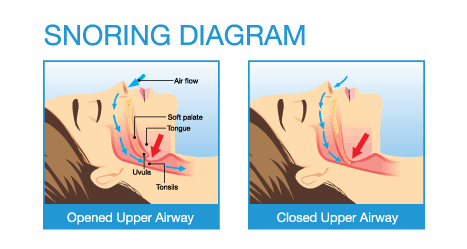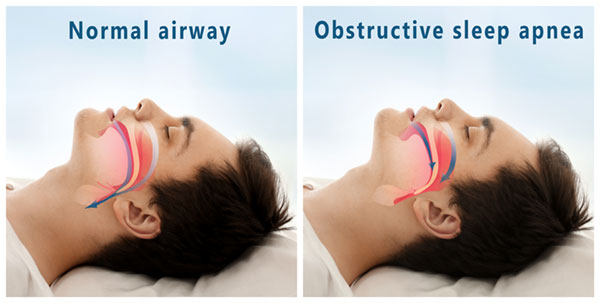
Snoring is a noise produced during sleep that originates in the back of the throat or nose. Snoring occurs when the muscles in the back of the mouth, tongue and throat relax while sleeping, which narrows or blocks the airway. Breathing causes your uvula (soft palate) to vibrate and knock against the back of the throat, resulting in the snoring sounds. Swollen or infected tonsils and adenoids, blocked nasal passages or deviated septum can also narrow the airway and lead to snoring.
Lack of sleep can make it difficult to work or simply enjoy life. Your snoring could also be a symptom of obstructive sleep apnea. A long-term pattern of sleep interruptions, including sleep apnea, can cause serious health problems. Our ENT specialists can help determine where your area of obstruction lies and can order a sleep study to determine if you have sleep apnea.
Sleep Apnea
Sleep apnea is a potentially serious disorder, in which breathing during sleep repeatedly becomes too shallow, or stops altogether. The most common type of sleep apnea is called obstructive sleep apnea and occurs when the muscles in the back of the throat relax during sleep. When the muscles relax, the airway narrows or closes, and breathing momentarily stops. If you think you might have sleep apnea, talk to your doctor immediately.
Snoring
Snoring is a common problem experienced by many. While we sleep, the muscles in our body relax, including those in and around the throat.
As we breathe, air flows past tissues in the nose and throat, causing them to vibrate. The sound of this vibration is what we refer to as snoring. In its earliest stages, snoring may only cause minimal disruption to sleep. Chronic snoring can interrupt, and reduce the quality of sleep for someone, as well as those around them.
People who sleep next to a chronic snorer can lose on average one hour of sleep each night. Losing sleep can cause irritability, high blood pressure, difficulty concentrating and fatigue, which can be extremely dangerous while driving or operating machinery. Many couples cope with snoring by sleeping in separate rooms. This often puts strain on a relationship and contributes to a loss of intimacy.
There are ways to address factors that contribute to snoring. Losing weight, quitting smoking, avoiding alcohol prior to sleeping, or sleeping on your side can all help reduce snoring. For more severe cases, medical devices and surgery are available that may reduce disruptive snoring. If you or someone you know is living with a snoring problem, speak with your doctor and ask about which options may be appropriate for you.
Treatment & Procedures
- CPAP (most common medical treatment), which is a therapy that uses pressure from an air blower to circulate air through the nasal passages and upper airway.
- Tonsillectomy
- Adenoidectomy
- Uvulopalatopharyngoplasty (UPPP) is a surgical procedure that removes soft tissue on the back of the throat and palate, thereby increasing the width of the airway at the throat opening.
- Nasal Surgery: nasal obstructions such as deviated septum and enlarged turbinates, which may play a role in sleep apnea, can be corrected through appropriate surgical procedures.
- Hypoglossal Nerve Stimulation (HNS) – Inspire® Upper Airway Stimulation is a Federal Drug Administration (FDA) approved treatmentthat includes an implantedsystem, and a patient remote. Inspire is indicated for second-line treatment of moderate to severe Obstructive Sleep Apnea in adult patients with an apnea-hypopnea index (AHI) between 15 and 65. Inspire therapy is not intended for patients with a complete concentric collapse at the level of the soft palate, or those in whom central and mixed apneas make up 25% or more of their apnea-hypopnea index. Read More about Inspire®
Patient Education & Resources
Snoring & Sleep Apnea: http://www.entnet.org/node/1418

